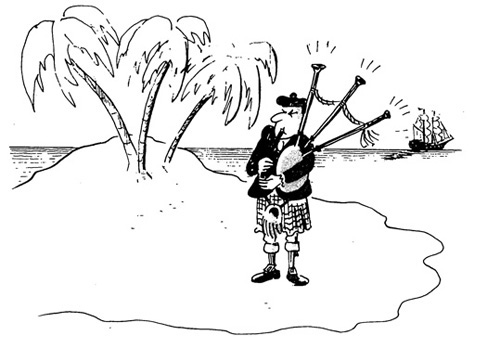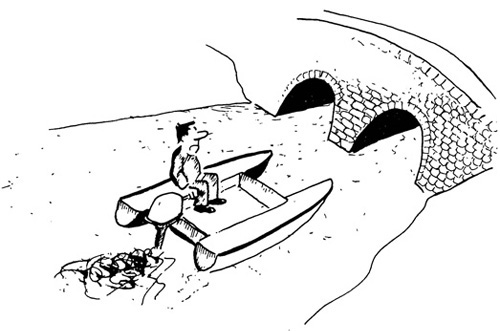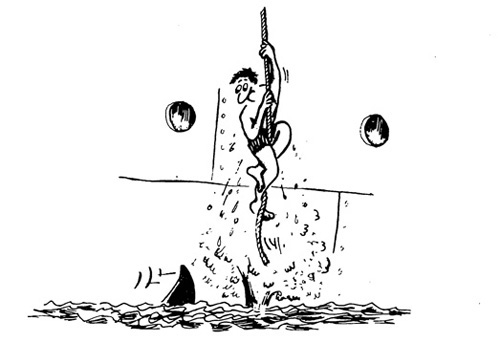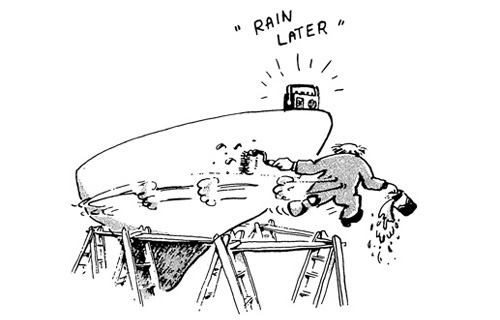Salty Dog Talk (3 page)
Authors: Bill Beavis

From the position of two pulley blocks which have been hoisted to a point where they touch and no more purchase can be gained. Block is the nautical word for pulley, and chock is to secure or render solid. Thus full to capacity. The expressions ‘to be choked’ or feeling ‘chokker’ also come from this.
This typically New England term for a seafood soup was introduced to the American coast by the Breton fishermen who worked in the waters of the Maritime Provinces. It comes from the French
chaudière
, a cauldron. This New England version of bouillabaisse, in its different forms, has created a culinary civil war along the New England coast. In the States of Maine and Massachusetts chowder is made of milk, clams or fish and potatoes and onions. In New Hampshire and to the south it is made with water, seafood and tomatoes. These last are a pure sacrilege to the Maine and Massachusetts purists, so much so that almost every decade a semi-serious, semi-spoofing bill is introduced into the Maine Legislature making it illegal to put tomatoes into chowder within the State. The penalty? Dig a barrel of clams at high water!
Note
: It is impossible to dig clams at high water for they are covered, hence the meaning of the American expression
Happy as a clam at high water
– ecstacy, the only time the clam feels safe.
In sailing ships the order would be heard to ‘clap on more sail’ meaning to make the ship go faster by setting extra sails. The word clap is from the action of the crew clapping their hands around the halyards which hoisted the sail. It probably spawned that other colloquialism:
going like the clappers
.

Castaway
It was the custom in the old days to record the courses and distances on a log slate and, at the end of the watch, transfer this information into the deck logbook. When this was complete, the slate was wiped clean for the next watch to take over. From this comes the notion of forgetting what has gone before and starting anew.
Term given to the effect of a monstrous sea which sweeps everything off the deck, frequently including the superstructure. The following is an extract from a letter published in
Yachting Monthly
in 1975 from someone who had survived a typhoon.
We saw it building up astern. It grew higher and higher until we were looking up at its crest. Then it fell upon us with a terrific crash and roar. We had two lifeboats on the poop which flew into the air in a shower of planks, spars, sails and other gear. A solid wall of water rushed along the after deck carrying all before it – ventilators, hatches, tarpaulins, wire reels, hen coops, everything movable and immovable. It burst in the doors of our accommodation, knocking out all the teak panels and flattening the rails down to the deck. Then along the foredeck and up and over the foc’sle head and back into the ocean. In one minute we had been swept clean.
The yardarms were the outer portions of the yard used in sailing ships for hoisting flags or, when punishment by death was current, hanging condemned men (hung from the yardarm).
The term to clear one’s yardarm referred to the job of slewing the yards or swinging them inboard so their ends would not obstruct the yards of another ship or quayside building which might have fouled them. Now, means to exonerate oneself, to prove innocence.
The preparatory order to battle which entailed lowering the ship’s side rails and screens, swinging out the boats and removing all items of loose gear from the ship’s upper deck. This provided a clean sweep for the guns and reduced the risk of extraneous fires breaking out.
A clew is a small metal ring fixed into the sail so that a rope may be attached. Clews appear in several places, the lower corner of the sails being the most significant. To ‘clew up’ was the order given to stow the sails which was done by furling their clews up to the yards. In time the term came to mean any job which entailed tidying up or securing. ‘Clue’ is merely a variant spelling but the two are usually differentiated – a clued-up person being somebody on their toes.
The name given for a defensive structure used in merchant ships and erected when attacks by privateers were expected. It consisted of heavy baulks of timber placed around the after deck or quarters, to form what was virtually a small fort. Holes were cut in the timbers through which muskets could fire. They were very effective. Falconer’s
Marine Dictionary
of 1771 records that the concentrated fire of an English merchant ship fitted with close quarters defeated the united efforts of three French privateers who attempted to board her. Incidently the holes through which the muskets were fired were called ‘loopholes’ from the French
louvre
or window. The word is now used to mean gaps in the law.

Chancing your arm
The phrase first appears in print in 1531 where it describes a vessel which had safely cleared the coast, then later Shakespeare used it in
Henry VI
as a reference to visibility. Neither of these references touch on its true insinuation; it is a reference to smuggling surely? Or some nefarious operation.
People are shy of using this in polite conversation, although quite unnecessarily so. The expression refers to the untidy custom of leaving the yards not square and neatly braced up but cock-billed or cocked-up at different angles. Considered a very unseamanlike practice, hence the allusion to something badly done.

Close quarters
It is said that the expression dates back to the 17th century when ‘ready use’ cannon balls were stacked on metal trays called ‘monkeys’. These had dished recesses so that each cannon ball was kept in position just touching its neighbour and in calm weather more balls could be stacked on top to form a pyramid. The monkeys were generally of iron but in some ships brass monkeys were used for ceremonial reasons. Normally, the arrangement was satisfactory, except in very cold weather when the different coefficient of expansion meant that the brass trays would contract more speedily than the iron causing the pyramid to collapse and the balls to fall off the monkey. (Although this story has been current for several years nobody has come forward to confirm or deny it. Nor has anyone complained!)
The national flag or ensign was known aboard ship as her
colours
– and a very important issue when ships engaged in battle as the survival of so many of today’s expressions explain. True
colours
, false
colours
, show your
colours
, nail your
colours
to the mast, go down with
colours
flying, come off with flying
colours
, etc., etc.
The term dates back to the 18th century when copper plating was first used to protect the underwater part of a ship’s hull from worm and particularly the very fast nibbling toredo worm of the tropics. It was a significant step forward in shipbuilding where previously a poor defence had been to paint the ship’s hull with tar. A Spanish squadron which had suffered losses in action decided to build a new ship in Equador. They completed the hull, launched it into the river at Guayaquil then sailed north to Panama to choose some suitable trees for masts and spars. When they returned, several months later, the wooden hull had all but been eaten away!
It was the sailor’s way of measuring a short period of time and alluded to the speed with which a sail would begin to shake when the helmsman’s attention wandered and he allowed the ship to head too closely to the wind.
To ‘crack on’ meant to set more sail and so attain a better speed. The word almost certainly relates to the loud retorts which are heard as the straining sails and sheets are eased. The order ‘crack the sheets’ is to ease them, usually because the wind has freed.
A colloquialism borrowed from boatwork where the expression was formerly to ‘
crab
one’s style’. A smart boat’s crew is the ambition of every ship in the navy where it used to be said ‘a ship was known by her boats’. If an oarsman were to miss his stroke and tumble backwards, or in rowing terms ‘catch a crab’ it would most definitely ruin their style. Also heard ‘crimp one’s style’.
The founder of the Royal Navy, King Henry VIII decreed that no junior captain should
cross the bows
of his Admiral. In other words put his ship to windward in a position where it could blanket the wind of the senior vessel and stop her. It has remained a part of naval etiquette ever since (a junior ship must still request permission to cross the bows of a senior ship). In international law there exists the rule that no ship must, except under extreme circumstances, cross the bows of another
Some believe this derives from the action of cutting through the anchor rope with an axe to hurry departure, but only under extreme conditions would any captain be prepared to lose an anchor. It is more probable that the expression refers to the standard practice amongst square-rig ships anchored in an open roadstead of having their sails furled with expendable lashings. If the weather threatened or the enemy arrived, the sails could be set quickly by cutting through the lashings. The ship might then be able to
run
off before the wind. However there are instances of ships trapped by an enemy, cutting through their anchor cables to effect a fast and noiseless escape. In 1782 Admiral Hood extracted his fleet from under the noses of the French in St Kitts by cutting through the hemp cables and running off before the wind.

Cracking on
Other nautical expressions related to this are to
cut loose; cut the ties
(sails held with thin lines called ‘ties’) and
break out
. Unfettered sails are always said to have been broken out.
First impressions, judging a person by appearance. Sailors had a penchant for apportioning ship names to various appendages of the body, toggle, bobstay bumpkin, transom, etc. So it is quite probable that the
jib
refers to a person’s nose. Some claim it has a literal meaning and does indeed refer to the shape of an approaching ship’s jib sail which used to be an indication of her nationality. French and Spanish ships were supposed to have had their jibs cut very much higher than those of the British ships. On the other hand, incessant wars, prizes and privateering meant that relatively few ships ever remained under their original flag. So the practice would not have been very reliable.
